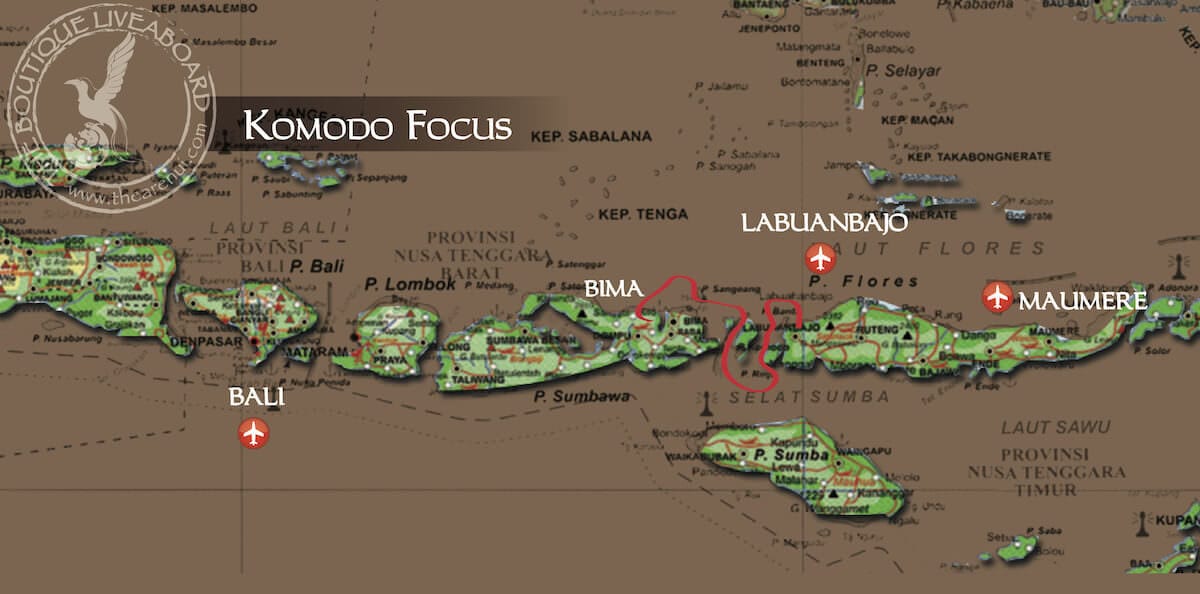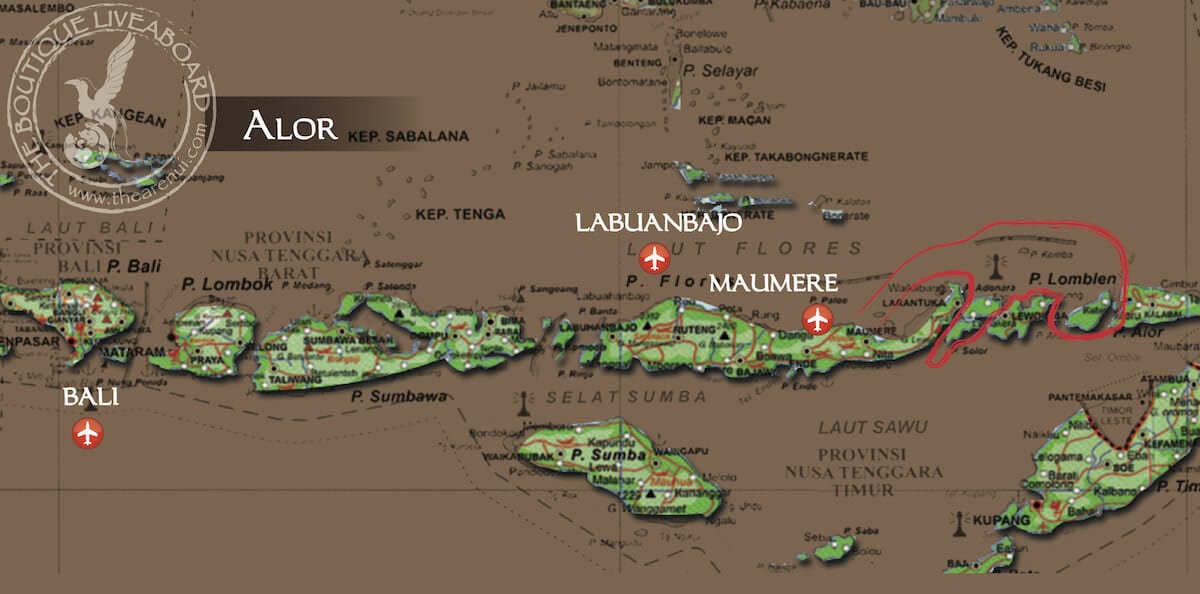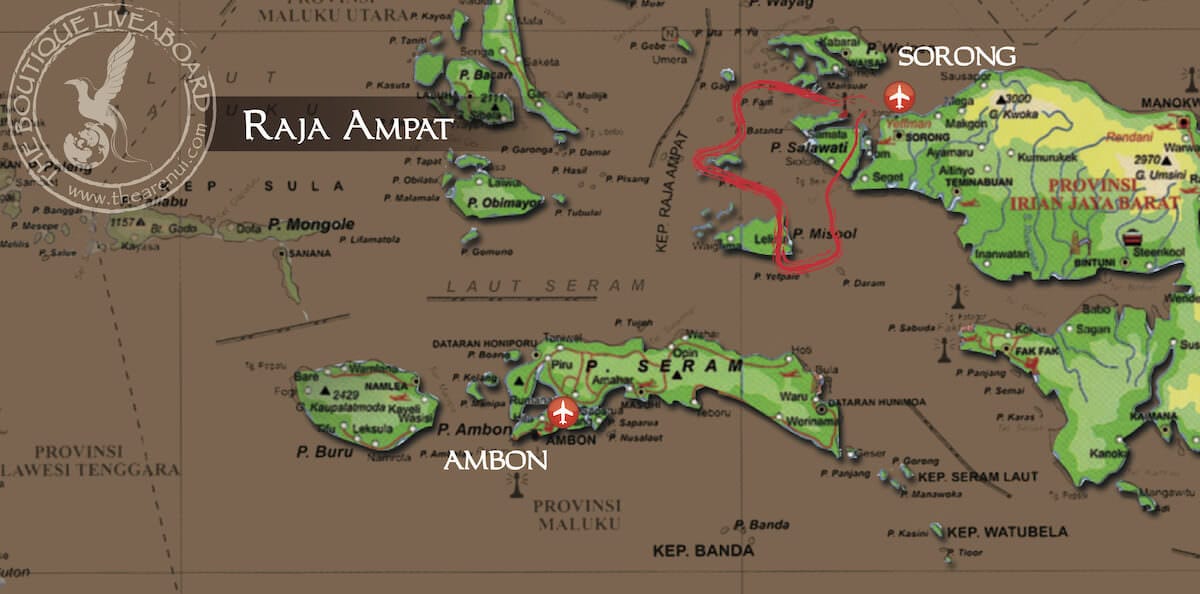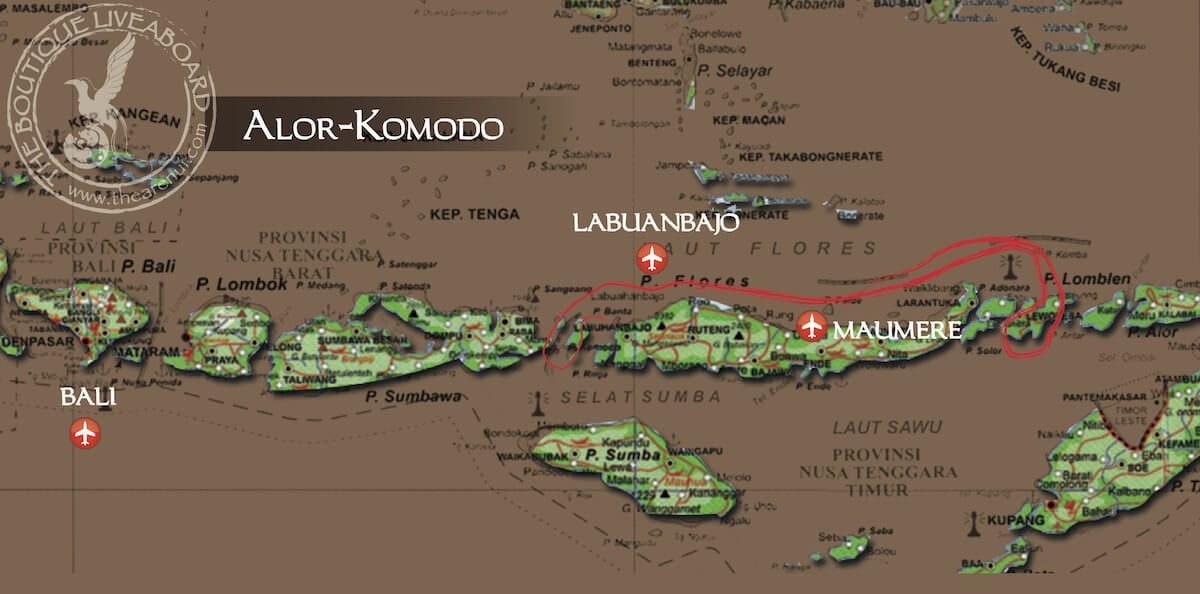KOMODO FOCUS
11 Days/10 Nights Bima – Labuanbajo Cruise Itinerary
Day 1 Embarkation in Bima
Day 2
Bima (4 dives)
Bima is a busy port on the northwest end of Sumbawa Island with world class muck diving. We spend the whole day here enjoying the hunt for the most rare and elusive critters.
Unusual Suspects
This muck dive is full of weird and wonderful critters. Starting in the south, the black sand is covered in sponges with frogfish, tiger shrimps and seahorses making their homes there. Fire sea urchins house Coleman shrimps and zebra crabs and ghost pipefish are a regular find. Continuing north, huge soft corals grow out of the sand and shelter beautiful cowries. The sandy slope turns into a rocky area where juvenile pinnate batfish, harlequin sweetlips and barramundi cod wiggle around. Thorny seahorses, seamoths, stonefish, razor fish and even wunderpus, mimic and blue-ringed octopus can be found in the next section of sandy slope.
The reef comes alive at night with the entire sea floor covered in all shapes and sizes of shrimps and crabs with a chance to see Spanish dancers, harlequin shrimps and bobtail squid. Other cephalopods come out at night so look for coconut, white V and algae octopus as well as long fin squid.
Day 3 Sangeang Island (4 dives)
The island of Sangeang is located northeast of Sumbawa. It’s a fairly small island but you’ll notice it right away since most of its landscape consists of Gunung Api, an active volcano. This natural phenomenon has made for some amazing topography, such as steep ridges dripping with hardened lava. There are several excellent dive sites here, all with good visibility, allowing you to truly appreciate the healthy reefs of soft and hard corals as well as different types of anemones.
Hot Rocks
Here the volcano has left its mark below the surface as well. In the shallows observe volcanic bubbles escaping from the seabed through air vents. Put your hands close to the ‘hot rocks’ and feel the heat from the sulphur-covered rocks. Besides the usual tropical reef species ribbon eels, cowries and Bargibanti pygmy seahorses can also be seen here.
Lighthouse Reef
This site presents many contrasts in terms of natural features and marine life. Strong currents can prevail in the exposed areas but there are also sheltered spots. Down around 20 metres macro lovers will be delighted, as the base of the wall and large black sand slope is excellent for spotting countless nudibranchs and other colourful critters. Black coral bushes hide ghost pipefish and saw blade shrimps.
Black Diamond
The rocky formation up in the shallows with fingers of coral going to the deep are covered with black coral and crinoids in any colour you can imagine. The black sand acts as a background to all the colour of this dive site and the corals will stand out in a way that you’ve never seen before. Among the black coral we often get to see one of the most incredible masters of camouflage, the ornate ghost pipefish and as the name suggests any ghost pipefish are a plus for divers. Big reef octopus, peacock mantis shrimps and nudibranchs are also seen here.
Bontoh Reef
Is located in the west part of Sangeang volcano where we have incredible sunsets and for this reason Bontoh Reef is a perfect place to dive as a third dive and night dive. With a very shallow area of black sand and small rocks covered with algae that gently slope down, Bontoh offers one of the biggest populations of spaghetti garden eels coming out from the sand. Among the small rocks is the perfect place for creatures to hide from predators and photographers. Critters spotted here include painted frogfish, juvenile angelfish, mantis shrimps and while we are swimming out in the sand we have the chance to see the wunderpus or mimic octopus.
Day 4 Gili Lawalaut (4 dives)
Two celebrated dive sites await you, just north of Gili Lawalaut Island. Crystal Rock and Castle Rock are both incredible locations, boasting the key elements for any impressive dive site: a wide variety of healthy corals covering the reef, plus tons of fish – both big and small and all sizes in between! There are two more exhilarating dives in this area, El Toro and Gili Lawalaut Lighthouse, along with good night dives on healthy hard coral reefs off the island of Gili Lawa Darat. Between the dives there is a chance to visit Gili Lawalaut Island and take a short trek to the top of the hill for a wonderful view over the Komodo-Flores channel.
Crystal Rock
The rock jutting out of the surrounding crystal clear waters explains how this site got its name. But what is truly memorable here are the large schools of fusiliers and anthias flitting over the gorgeous soft corals and impressive table corals. In the deep blue, you can also see at times large tuna, mackerel and other fish schooling around a small mound to the northwest. A lone eagle ray is often spotted here cruising in the currents.
Castle Rock
Castle Rock is a submerged pinnacle situated a kilometre further north from Crystal Rock. Its exposed location means strong currents but experienced divers will love the thrills to be had on this dive. In fact, the main action comes from watching the staggering amount of fish such as batfish, groupers, midnight snappers and impressive schools of fusiliers and surgeons whipping past. Of course, divers aren’t the only ones interested in the huge amount of fish here, which explains the giant trevally as well as whitetips, blacktips and grey reef sharks hunting around for their next meal.
El Toro
The channel between Gili Lawalaut and Gili Lawa Darat forms a dive site with interesting topography. The dive starts with a drift along a sloping reef and sandy bottom. Corals heads shelter crocodile fish and lionfish hunting in the small schools of glassfish. Pygmies and frogfish have been seen here as well eagle rays and reef sharks. The dive site then shallows out with the ‘bull ring’ circle opening out and ending in a flat rock plateaux. There is also a chance to see manta rays playing in the surface currents.
Gili Lawalaut Lighthouse
On the north of Gili Lawalaut there is a lighthouse at the end of a long reef. When the tide is going down the dive starts on the reef with a drift to the corner. At the corner there are big schools of batfish, snappers, surgeons with napoleon wrasse and reef sharks also hanging around.
Day 5 Komodo-Flores Channel (4 dives)
Currents in this area can be quite strong and we have to dive according to the tides. There are many dive sites and the sites chosen will be dependent on the currents. Finish the day with a great night dive at Wainilo. Komodo is an excellent place for spotting macro critters and the reefs and corals are spectacular too. See some photos here.
Karang Makassar
This is an exhilarating drift dive along the shallow flat bottom interspersed with patches of coral reef teeming with life. There are chances to see turtles, eagle rays and white tip and black tip reef sharks. But the main reason we dive here is to hopefully see manta rays. Reef mantas come here to visit the cleaning stations but they can also be spotted, mouth wide open, feeding on the surface. This area can also be a very good snorkelling spot.
Batu Bolong
Underwater this rock is covered in a huge amount of soft and hard corals and full of fish life. In the shallows watch anemone fish and look out for turtles munching on the corals. Giant trevally, white tip reef sharks, snappers and emperor fish tend to congregate here. This site presents particularly good opportunities for both macro and wide-angle photography.
Tatawa Besar
This is a thrilling drift dive that starts off from the northwestern tip of Tatawa and continues down the western side towards 15 to 20 meters of depth. The surrounding fish life is profuse and you will see an endless field of stunning orange soft corals as you glide along. Swim past coral heads inhabited by schools of sweetlips and batfish and look out for turtles feeding on the reef. Mantas have been encountered here as well.
Tatawa Kecil
The West side of this small rocky outcrop presents a fantastic underwater terrain with enormous slabs of rock that have been worn down to form channels, canyons, caves and swim-throughs. On the north plateau crocodile fish lie on the scenic reef among a whole host of reef fish and schooling fusiliers.
Batu Tengah
This dive site is located in the middle of the Komodo National Park, 12 nautical miles to the north and 12 nautical miles to the south. The translation of Batu = Rock, Tengah = Middle. With a slope to the east of the site and a coral garden to the west Batu Tangah is a beautiful site where we often get to see turtles, cuttlefish and juvenile white tip reef sharks that hide under the table corals among the hard coral garden. Napoleon wrasse and big groups of snapper swimming on the slope with all the colourful decoration of the soft coral make Batu Tengah a high quality dive site.
Wainilo
This night dive is situated off the north of Rinca Island. In the shallows, the hard coral reef is home to many different critters, including juvenile harlequin sweetlips and batfish. Away from the reef, the sandy slope is scattered with pulsing soft corals that hide demon stingers and starry night octopus, plus a moray eel that has not yet been classified by scientists and is only found here in Wainilo.
Day 6 Walk with dragons/Padar Island (2 dives)
Loh Buaya (walk with dragons)
Your day will begin with an exciting visit to Komodo National Park where you will be able to take a stroll with the famous dragon! Take a look at our Komodo Dragon photo album here. As you walk along the paths, also stay on the lookout for deer, wild boar and birds in addition to the giant lizards. After the walk we move to Padar Island for two dives.
The water temperature here and in the southern dive sites over the next few days can be a little cooler dropping from the normal 28/29 degrees Celsius (82-84 Fahrenheit) to a possible 20 Celsius (68 Fahrenheit). Also due to the infinite nutrients in the water creating the amazing biodiversity in this area the visibility can sometimes be a bit greener. Neither one of these factors can spoil the amazing diving to be had in these areas.
After the second dive we visit one of the most incredible beaches in the Komodo National Park. A short walk brings us to the pink sandy beach. During this walk we also have the opportunity to see enjoy incredible views of the National Park with the sunset.
Three Sisters
The site here are full of interesting and beautiful features, such as massive steps and huge towers of stone, all wrapped in hard and soft corals and dotted with nudibranchs, small caves and overhangs. Reef sharks and humphead parrotfish are among the bigger creatures we see in this area. There is also a towering coral spire with a small cave at the bottom, where huge lobsters are often found hiding. Look for the tiny lady bugs on the soft corals and the resident frogfish sitting in the sponges.
Secret Garden
Is one of the top dive sites at Padar Island. As the name of the dive site suggests it has a beautiful coral garden of black coral along a mini wall covered with soft corals. There is a resident school of mobula rays that seem to like swimming through the dive site giving good opportunities to the divers to see them. Nudibranchs, leaf fish, frogfish and the incredible sea apples can be seen here too.
Day 7 & 8 Rinca Island (8 dives)
Horseshoe Bay is in the south of Rinca Island and we spend two full days here. Here we dive the famous Cannibal Rock, one of the top ten dives sites in the world according to some diving publications. Watch dragons, wild pigs, deer and monkeys roam the beach and take a tender ride or kayak to get a closer look.
Cannibal Rock
This outstanding dive site covers a large area with sandy slopes in the north, deep mini walls in the east, a plateau full of life in the south and rocky areas in the west. The nutrient rich bay creates the most spectacular congregation of hard and soft corals in all parts of the dive site. Sponges, ascidians, sea squirts and tube anemones are abundant. A great diversity of nudibranchs can be seen here, along with frogfish, turtles, cuttlefish and other reef fish too.
Yellow Wall of Texas
As the name suggests this wall at the southern entrance to Horseshoe Bay is covered in yellow and orange soft corals. A tiny critter, the ladybug, comes in its multitudes here. Nudbranchs decorate the wall that usually has a slight current enabling you to slowly drift along and enjoy the view.
Crinoid Canyon
Another wall on the opposite side of Horseshoe Bay with deep bommies covered in soft corals and huge gorgonian sea fans. Here ribbon eels and giant frogfish have been spotted along side the hundreds of crinoid which give this dive site its name.
The Boulders
Inside the bay and opposite Yellow Wall of Texas there are large rocks that continue underwater to create places for large rays to rest and even sometimes nurse sharks hide in these underwater crevices. The boulders are covered in corals becoming a paradise for marine life. The elusive Rhinopias have been found here before.
Rhino Rocks
There is a group of rocks that at low tide break the surface that we call Rhino Rocks. This is because there has before been found the elusive Rhinopias. It is a shallow dive site with a sloping reef ending at the rocks that are covered in corals of all kinds. The reef is an excellent place to look for nudibranchs, frogfish, juvenile batfish, zebra crabs, turtles and cuttlefish. This dive site also makes an excellent night dive when you should look out for Coral Catshark.
Banana Island
Another incredible dive site named by the shape of the Island, this small island is close to Nusa Kode Island, great dive site for a third dive. Banana Island has beautiful hard coral formation in the shallows and at 15mts/45ft depth we can see some boulders cover with soft corals. Giant frog fish, broad cuttle fish, reef octopus and some special nudibrachs have been seen here. Keep always looking out into the blue for schools of mobula rays, we have seen them here once in a while.
Torpedo Alley
A marvelous night dive named after the pancake sized torpedo rays that can be found here. Coconut octopus, seahorses, colourful squid and the bizarre bobbit worm all live in the black volcanic sand. A very shallow dive with a maximum depth of 10m/30ft, spend time looking for all the strange inhabitants among the rocks, soft corals and in the sand.
Day 9 Manta Alley/Pink Beach (4 dives)
Manta Alley is located on the south end of Komodo Island. After two dives looking for manta rays we head up to the middle of Komodo Island to the Pink Beach area.
Manta Alley
Manta Alley is located in Tora Langkoi Bay along the south coast of Komodo. The dive site in fact barely pierces the ocean’s surface at the end of a line of rock islets. As can be guessed from its name many manta rays are known to frequent this site and it is the most popular one in Komodo for spotting them. The area can be described as a deep gully that works as a funnel when the tide changes, causing the water to rush through at speeds of up to three to four knots with the fall and rise of the tides and up to one knot even during “slack water” periods. Watch the mantas being cleaned on the North side or enter the ‘Alley’ to see them hover effortlessly in the current.
Pink Beach
The simple topography makes this site an ideal afternoon dive. A mini wall can be found in the middle of the reef, where clouds of glassfish swarm in the cracks and crevices. An abundant amount of fish life and unusual critters make their home here, including leaf scorpionfish, crocodilefish, nudibranchs and frogfish. On one side of the wall is a sloping coral reef full of life. On the other is a sandy area with healthy staghorn corals growing and providing shelter for juvenile harlequin sweetlips and mandarin fish.
Loh Liang Bay
This white sand muck dive is around the corner from Pink Beach situated inside Loh Liang Bay on Komodo Island. Search for all sorts of critters here – bobtail squid, flamboyant cuttlefish, frogfish, nudibranchs, Ambon scorpion fish, cockatoo waspfish and large moray eels living in the shallow rocks.
Day 10 Komodo-Flores Channel (4 dives)
Today we have another opportunity to dive the wonderful Komodo-Flores Channel. Finish the day with a great night dive off the island of Gili Lawa Darat.
Karang Makassar
This is an exhilarating drift dive along the shallow flat bottom interspersed with patches of coral reef teeming with life. There are chances to see turtles, eagle rays and white tip and black tip reef sharks. But the main reason we dive here is to hopefully see manta rays. Reef mantas come here to visit the cleaning stations but they can also be spotted, mouth wide open, feeding on the surface. This area can also be a very good snorkelling spot.
Siaba Kecil
Here at Siaba Kecil we have a magnificent formation of hard coral from the shallows of the island till a depth of 20m/60ft. The current running from the south to north is the best way to dive this site. During the drift and also at the end of the drift we have a great chance to see green and hawksbill turtle feeding on the formation of hard coral, white tip reef sharks also can be seen here. Reef manta rays can occasionally swim by the coral garden of this site.
Sebayur Island
This island has a white sandy slope that turns into a mini wall. Look for leaf fish, ghost pipefish and a variety of nudis at the edge of the reef. Various nudibranchs, lionfish and moray eels make the wall their home. In the shallows the hard corals are decorated with anthias and we often find large cuttlefish and juvenile bicolour parrotfish.





